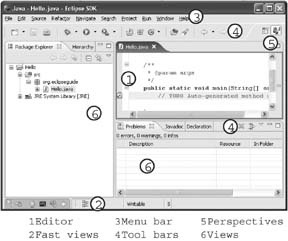Chapter 2. Workbench 101
Eclipse's main window, called the workbench, is built with a few common user interface elements (see Figure 2). Learn how to use them and you can get the most out of the IDE. The two most important elements are views and editors. If you're already familiar with the Eclipse workbench, you can skim this section or skip to Part III to start programming.

Figure 2-1. The Eclipse workbench is made up of views, editors, and other elements.
Views
A view is a window that lets you examine something, such as a list of files in your project. Eclipse comes with dozens of different views; see Table 2 for a partial list. These views are covered in more detail in Part VII.
Table 2-1. Commonly used Eclipse views
|
View name |
Description |
|---|---|
|
Package Explorer |
Shows all your projects, Java packages, and files. |
|
Hierarchy |
Displays the class and interface relationships for the selected object. |
|
Outline |
Displays the structure of the currently open file. |
|
Problems |
Shows compiler errors and warnings in your code. |
|
Console |
Displays the output of your program. |
|
Javadoc |
Shows the description (from comments) of the selected object. |
|
Declaration |
Shows the source code where the selected object is declared. |
To open a view, select Window â Show View. The most commonly used views are listed in that menu. To see the full list, select Otherâ¦.
Most views have a titlebar that includes ...
Get Eclipse IDE Pocket Guide now with the O’Reilly learning platform.
O’Reilly members experience books, live events, courses curated by job role, and more from O’Reilly and nearly 200 top publishers.

